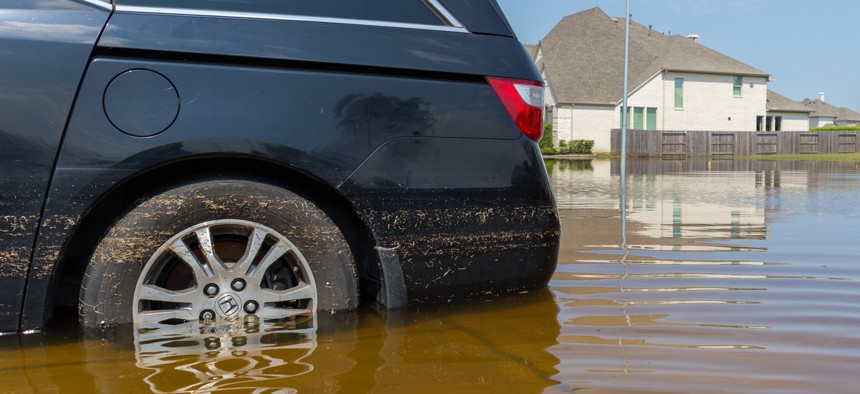2018 Hurricane Season Awaits Communities Still Recovering From 2017

Flooding in Missouri City, Texas following Hurricane Harvey on Sept. 1, 2017. Shutterstock
Local officials have pushed for hazard mitigation funds as well as outstanding FEMA reimbursements.
WASHINGTON — Local government officials at a Senate Commerce hearing Thursday stressed the need for Federal Emergency Management Agency funds upfront for hazard mitigation ahead of a 2018 hurricane season where forecasters are anticipating 14 named storms.
The 2017 season saw 17 named storms and three Category 4 hurricanes, which also happened to be three of the five most most damaging on record, for comparison.
Puerto Rico still lacks electricity and potable water in places, and many Texas and Florida localities await FEMA reimbursement for debris removal.
“I can take $15 million and prevent 2,000 homes from flooding that flooded during [Hurricane] Harvey with pumps that were inundated—we didn’t have enough of them—drain out ditches, taking care of things that mitigate storms that would prepare us,” Missouri City, Texas Mayor Allen Owen said during the U.S. Senate Commerce, Science and Transportation Committee hearing.
Owen wants to avoid a repeat of last August by working with the Army Corps of Engineers on alternative channels and holding basins for its 59-foot levee along the Brazos River. When the river hits 58 feet, 9,500 homes flood, he said, and at 59 to 60 feet the entire city is taking on water.
As Hurricane Harvey dumped unprecedented amounts of rainfall on southeastern Texas, Missouri City, a suburb southwest of Houston, required 1,300 high-water rescues. Most residents, 95 percent, lacked flood insurance—receiving a max of $33,000 for repairs—because they were outside a flood zone.
Meanwhile, Mississippi invested $50 million in hazard mitigation and estimates it avoided $100 million in damages when Hurricane Nate made landfall in October with a 12-foot storm surge, according to Jamie Miller, the state Development Authority’s chief innovation officer. Communities in Mississippi fortunately avoided any deaths, injuries or homes with major damage associated with Nate, the first hurricane to make landfall on the Magnolia State’s coast since Hurricane Katrina in 2005.
A state Homeowners Assistance Program has them elevate structures to base flood elevations and maintain flood insurance.
“Mississippi believes in hazard mitigation,” Miller said.
The situation is more dire in Puerto Rico, where Hurricane Maria disaster recovery continues even as the territory contemplates becoming more resilient.
The American Red Cross expects to be on the island anywhere from 18 to 36 more months, said Jennifer Pipa, the organization’s Central Florida regional CEO.
“We’re still delivering food to people who don’t have access to grocery stores that have power so that they can sustain,” she said. “We’re still giving out water filtration systems because there’s no potable water there, so there’s still a long time to go.”
Marathon is a city in the Florida Keys, which took the brunt of Hurricane Irma. The region boasts a $2.7 billion tourism-based economy, commercial and recreational fishery, and the third-largest barrier reef system in the world.
Ahead of Irma, local governments undertook a Keys-wide evacuation, something that hadn’t been attempted in a decade. Pipa said state and local authorities evacuated a historic number of people in part because they saw the images of stranded families in Texas after Harvey and took them to heart.
Marathon City Manager Chuck Lindsey said rapid recovery is critical to the Keys’ economy and environment.
“We responded as required: quickly, efficiently and responsibly, but in doing so depleted all our funds set aside for hurricane response on the understanding that initial federal reimbursement would come quickly,” Lindsey said.
But the “slow-to-respond” FEMA system has instead forced Marathon to pull money from remaining accounts, dip into 2018 revenues and secure large lines of credit, despite President Trump approving reimbursement coverage for the first 30 days of recovery. Marathon spent the money on pressing health and safety needs, initial debris removal and labor, Lindsey said, not large infrastructure or reconstruction projects.
Marine debris remains at “crisis levels” in canals and near-shore waters, Lindsey continued, despite the Coast Guard and Florida Fish and Wildlife Conservation Commission removing thousands of vessels already. Removal is impossible without at least the promise of reimbursement, notwithstanding cars and damaged homes posing a threat to residents and the Keys’ ecosystem.
“The witness has told us that they have not seen a single reimbursement from FEMA six months after a major hurricane disaster,” said U.S. Sen. Bill Nelson, a Florida Democrat. “And that just is inexcusable.”
Dave Nyczepir is a News Editor at Government Executive’s Route Fifty and is based in Washington, D.C.
NEXT STORY: New Worries Over Aging Underwater Pipeline in Great Lakes






